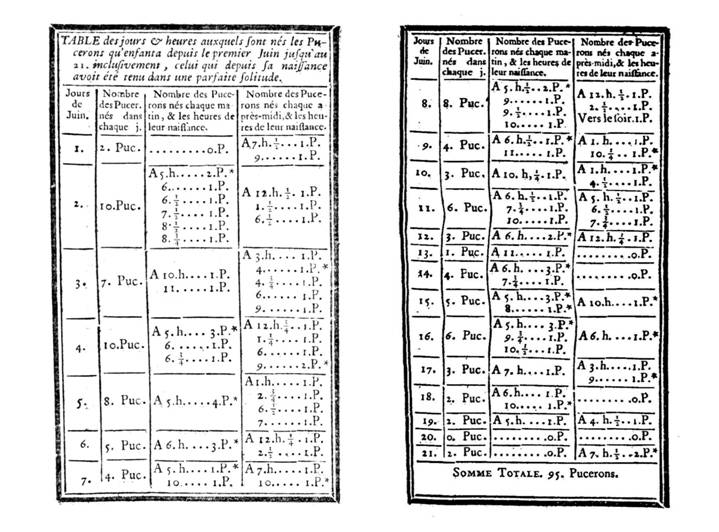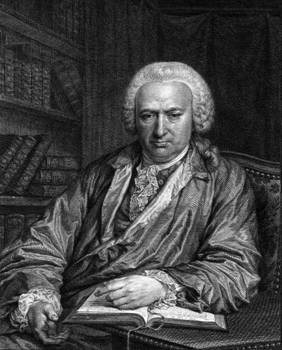Charles Bonnet and his Danae: the discovery of parthenogenesis
At 7.30 p.m. on June 1st 1740, in Geneva, a young man named Charles Bonnet watched the birth of an aphid. His account of the event (Bonnet 1745) suggests that his emotions at the time were akin to the pride and satisfaction of a young father at the birth of his first daughter. Twelve days previously, at 5 p.m. on May 20th, he had watched the mother of this aphid being born, and since that time he had kept her in meticulous isolation, anxiously watching her through four successive moults until she reached adulthood and provided him with the proof of virgin birth that he was looking for. He likened his role to that of Acrisius, the king of Greek legend who imprisoned his daughter Danae in a tower of bronze for fear that she would be impregnated.
Charles Bonnet was born in Geneva in 1720, the only son in a wealthy French family. He went at least partially deaf at the age of seven, and after being teased at school he received his first education from private tutors. In his teens he became increasingly absorbed in the wonders of nature, and in particular he marvelled at insect life, avidly reading the major books on natural history published in French at that time such as Spectacle de la Nature (1732) by Noël-Antoine Pluche, and in particular the series of volumes entitled Mémoires pour servir a l’Histoire des Insects (1734-1742) by the polymath René-Antoine Ferchault de Réaumur.
Réaumur is one of the most amazing people in the history of science, with interests ranging over the whole of science and technology, from bees to the building of bridges (Ratcliffe 2005). He greatly influenced the way in which science developed in the 18th century, by advocating and practising experimentation to dissociate the “true marvels” of the natural world from the myths and prejudices with which they had become so closely entangled in medieval times. He was also a great communicator. The young Bonnet found the wide-ranging ideas of Réaumur about insects especially exciting. A major part of the third volume of Réaumur’s Mémoires pour servir a l’Histoire des Insects, published in 1737, was devoted to the natural history of aphids and their natural enemies. In this volume, Réaumur suggested an experiment to rear aphids in isolation in order to prove whether, as had long been suspected, they could give birth without mating. Réaumur had tried to do this experiment himself several times, but without success.
So, in May 1740, Bonnet decided that he would make his own attempt, using an aphid of the black bean aphid (Aphis fabae) group collected from a spindle tree. He placed a twig of spindle bearing a few leaves in water in a glass vial, and buried the vial up to its neck in soil in a flower-pot. On one of the leaves he then placed a single aphid that he had observed being born, and inverted a glass vase over the twig so that its rim was in close contact with the surface of the soil. Then his vigil began, keeping daily watch on his “little prisoner” from 4 or 5 o’clock in the morning until 9 or 10 o’clock at night, and maintaining a precise account of everything that happened. Using a hand-lens he observed its moults with some trepidation, fearing at each one that it would fall from the plant and be lost. Eventually the day arrived when his charge attained adulthood, and his patience was soon rewarded. The young aphid born at 7.30 p.m. on June 1st 1740 was the first of 95 offspring born to his virgin mother in the next 21 days, every birth being meticulously recorded.

Fig. 1 Bonnet’s table recording the births of the 95 offspring (pucerons = aphids) of the virgin mother aphid in his 1740 experiment. The asterisks signify births that he did not actually observe.
Today, even to a non-scientist, this may seem a simple, almost naïve experiment. In the context of his time, however, its design and careful execution were exceptional, and won him the immediate honour of admission as the youngest corresponding member of the Academy of Sciences in Paris. One might question the lack of replication, and the wisdom of relying on a single individual aphid that could easily have been lost; but then part of the value of the experiment was the attention that he was willing and able to lavish on this one solitary aphid. In fact with the encouragement of Réaumur and other members of the Academy, Bonnet repeated the experiment next year with two more aphids from the spindle tree, and then went on to demonstrate parthenogenesis in several other aphid species. It had been put to him that impregnation of an earlier generation might have somehow been passed down to his aphids, so in July 1741 he set out to rear solitary aphids through a succession of generations, this time using the elder aphid (Aphis sambuci). He succeeded as far as the fifth generation, but then lost his aphid during transfer to a fresh elder leaf before it had attained maturity. The following year he succeeded in rearing his spindle-tree aphid through six generations, and an aphid on plantain through five, and in 1743 he took his plantain aphid through nine generations.
However, he was still worried that some prior impregnation might have occurred, and its effects passed down in some way through the generations. The trouble was that Bonnet, living more than 150 years before the science of genetics, had no real conception of how the essential characters of a species were passed from one generation to the next, nor of the real significance of sexual reproduction. His interpretation of his experiments was rooted in the idea of preformation; that is, that every female contained the preformed “germs” of all her descendants, and that these would develop if they were stimulated to do so as a result of insemination by a male, and then provided by the female with adequate nutrition. He knew he had demonstrated that aphid “germs” could develop without any stimulation by the semen of a male, or at least that mating did not have to occur in every generation, but he was unaware that the resultant offspring differed in any significant way from those resulting from sexual reproduction.
Bonnet knew that some aphid species had sex, and in fact he described and studied the behaviour of males and egg-laying females of the sexual generation of a large aphid* (“l’éléphant des pucerons” – probably Lachnus roboris) on the branches of oak. He then moved on to other lines of investigation in zoology and botany and made other important discoveries, for example he was the first to show that insects breathed through the series of lateral pores that we now call spiracles. Later in life his eyesight deteriorated and he was forced to cease his studies of living organisms. Instead he turned his attention to philosophical matters. His ideas on evolution – he was one of the first biologists to use this word – were very influential at the time, but were of course very different to those of Darwin nearly a century later, and seem strange to us today. He continued to believe that each female organism contains within its germ cells an infinite series of preformed germs put there by the creator, and hence that all life is preordained and that species are immortal and immutable.

Fig. 2 Charles Bonnet in the 1770s.
To explain the fossil findings of extinct species, Bonnet suggested that the earth is periodically struck by global disasters in which most organisms died, but then the survivors climbed to a new level in the scale of nature (“Bonnet’s ladder”). Thus, minerals became plants, plants became insects, and higher up the ladder fish became birds, and birds became quadrupeds. Man was of course at the top of his evolutionary ladder, and would develop into angels after the next global disaster. To our eyes today, Bonnet’s scheme of things (assuming that he was not entirely right!) comprises a remarkable mixture of truth and misconception.
In the next article I shall describe what we now know about the way in which aphids develop from unfertilised eggs. It will become evident that, 250 years later, we still have no complete answer to the mysteries of aphid parthenogenesis.
References:
Bonnet, C. (1745) Traite d’insectologie ou Observations sur les Pucerones. Durand, Paris 228 pp.
Ratcliff, M.J. (2005) Experimentation, communication and patronage: a perspective on René-Antoine Ferchault de Réaumur (1683-1757). Biology of the Cell 97: 231-233.